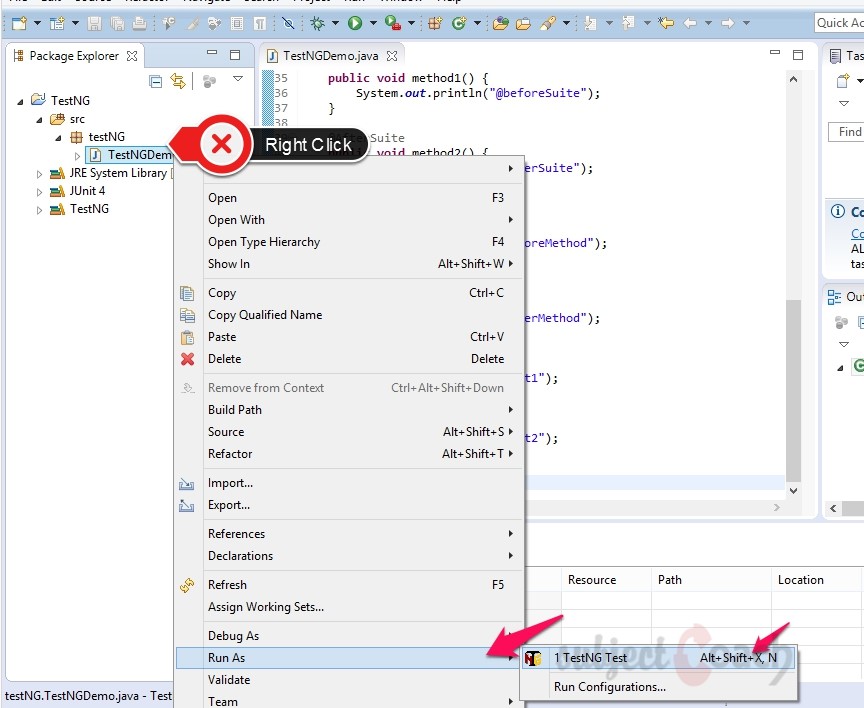Working with TestNG - Starters Guide
Chapters
Execution Procedure of TestNG Annotations
Here we explain the execution procedure of the TestNG methods. There is no format for defining testing methods. The order of the methods called is as shown below in example
Code example
package testNG;
import org.testng.annotations.AfterClass;
import org.testng.annotations.AfterMethod;
import org.testng.annotations.AfterSuite;
import org.testng.annotations.AfterTest;
import org.testng.annotations.BeforeClass;
import org.testng.annotations.BeforeMethod;
import org.testng.annotations.BeforeSuite;
import org.testng.annotations.BeforeTest;
import org.testng.annotations.Test;
public class TestNGDemo {
@BeforeClass
public static void DatabaseConnection() {
System.out.println("@Before Class");
}
@AfterClass
public static void disConnect() {
System.out.println("@After Class");
}
@BeforeTest
public void setUp() {
System.out.println("@BeforeTest");
}
@AfterTest
public void cleanUp() {
System.out.println("@AfterTest");
}
@BeforeSuite
public void method1() {
System.out.println("@beforeSuite");
}
@AfterSuite
public void method2() {
System.out.println("@afterSuite");
}
@BeforeMethod
public void method3() {
System.out.println("@beforeMethod");
}
@AfterMethod
public void method4() {
System.out.println("@afterMethod");
}
@Test
public void testExample1() {
System.out.println("@Test1");
}
@Test
public void testExample2() {
System.out.println("@Test2");
}
}
Now in you Eclipse IDE, Right click the TestNGDemo.java file and the Goto Run as > TestNG Test as shown below

Here is the output we get
@beforeSuite
@BeforeTest
@Before Class
@beforeMethod
@Test1
@afterMethod
@beforeMethod
@Test2
@afterMethod
@After Class
@AfterTest
PASSED: testExample1
PASSED: testExample2
===============================================
Default test
Tests run: 2, Failures: 0, Skips: 0
===============================================
@afterSuite
===============================================
Default suite
Total tests run: 2, Failures: 0, Skips: 0
===============================================
The execution procedure is:
- BeforeSuite() method is executed only once as first of all.
- AfterSuite() method executes only once at last of all.
- Methods beforeTest(), beforeClass(), afterClass(), and afterTest() are executed only once.
- Before executing each test case beforeMethod() method executes.
- After executing each test case afterMethod() method executes.
- Each test case executes in between the methods beforeMethod() and afterMethod(),.
In next part of this tutorial we will check out how to execute tests
Description
This tutorial is focused on getting you started on TestNG, the testing framework inspired from JUnit and NUnit. Here is a quick table of contents
- What is TestNG?
- Environment Set-up
- Writing Tests
- Basic Annotations
- Execution Procedure
- Executing Tests
- Suite Test
- Ignore Test
- Group Test
- Exception Test
- Dependency Test
- Parametrized Test
- JUnit Tests
- Test Reports
- Running tests without Eclipse
- Plugin with ANT
Environment
A computer capable of running Java. IntelliJ Community IDE is also required for this course.
Prerequisites
Good knowledge of Java programming language and eclipse is essential.
Audience
Students looking to get started with TestNG
Learning Objectives
This tutorial will get you started with TestNG.
Author: Subject Coach
Added on: 12th Mar 2015
You must be logged in as Student to ask a Question.
None just yet!